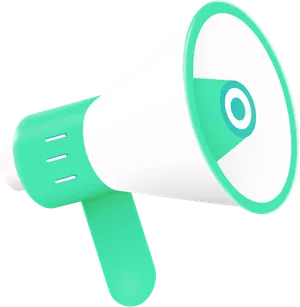Blogging on Shopify: How To Do It For SEO Traffic

This article is Chapter 5 of our 288-page Shopify SEO guide.
Check out the full eBook.If you’ve looked into digital marketing today, you’ve probably seen two conflicting ideas:
- Every business should have a blog.
- Nobody reads blogs anymore.
The truth is, they’re both kinda right.
Blogging as a community engagement tool has mostly been reduced to social media instead.
But as a business growth tool? It’s huge.
Let me explain why and how you can capitalise on this.
Why you need a blog
Some people will tell you to start a blog to keep your website “fresh”.
But that’s pointless, you can update your existing pages for that.
A blog has one purpose only: to increase traffic.
You can do this in two ways:
- Rank your blog posts in search engines.
- Increase the rankings of your category pages via internal linking.
Let me explain…
Informational Intent
We talk with a lot of eCommerce brands at Logeix, and while most of our recommendations are the same - sometimes their specific niche is different.
One place this can vary wildly is intent.
Let’s say someone goes to Google and searches for “best carry on luggage”, what do you think that person is looking for?
If you said a shop, you’re probably wrong. Most SEOs would guess they’re looking for a comparison, which usually would be a guest post.
As we can see, the search results match that:
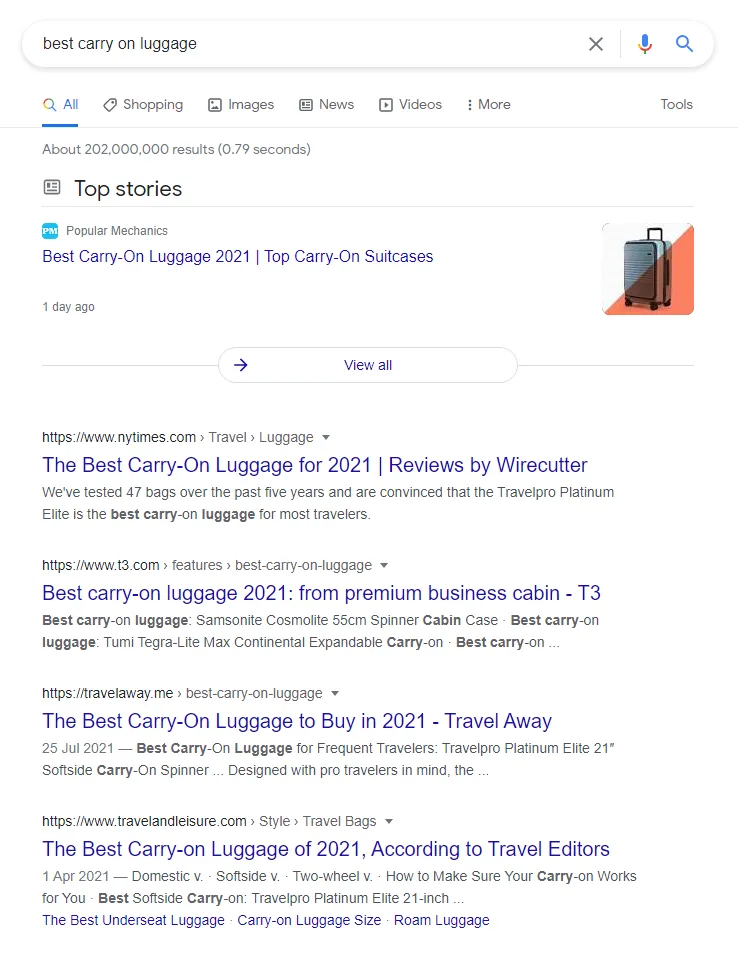
This is what we call informational intent.
But what if someone searches for “carry on luggage”, most people would presume that means they’re looking for a store to purchase it.
Unfortunately, a quick Google search shows differently:
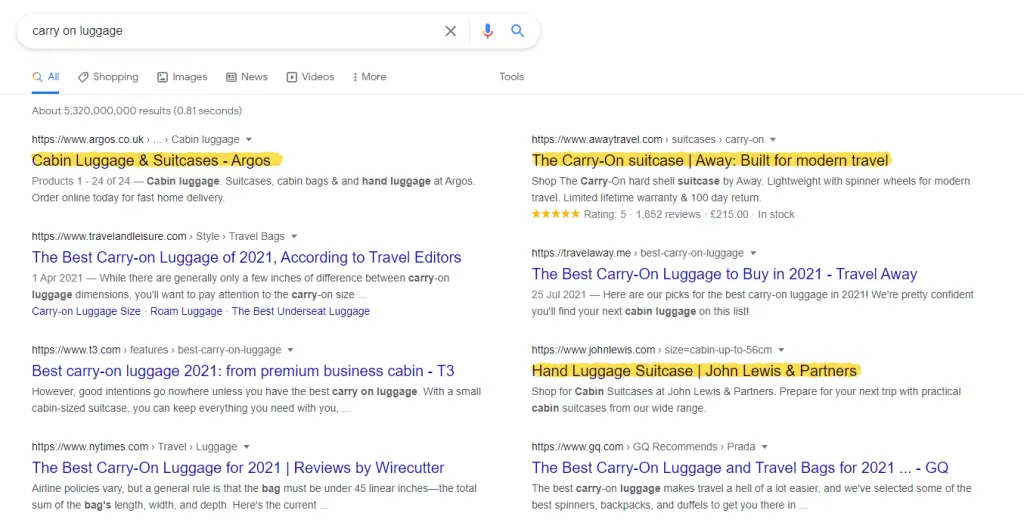
While there are 3 eCommerce category pages in the results, the vast majority are informational, including comparisons and airport sizing advice.
This is what we call mixed intent.
The truth is that not all keywords in your market will be transactional intent, some will be informational, and in many cases, important ones will be mixed.
(In fact, the trend we’re seeing is a shift towards mixed in most industries)
This means it’s extremely important to not only have your category page selling carry-on luggage, but also a review blog post comparing the best carry-on luggage, and possibly even another with sizing guides for different airlines and countries.
Not only will this open up possibilities for search rankings, it’ll also help with ranking your category pages when these are utilised for internal linking.
Middle of Funnel
While there may be potential simply reviewing your existing category pages and identifying mixed intent keywords, there’s likely even more in identifying middle of funnel keywords.

Your middle of funnel content is the bread and butter of ecommerce blogs. While top of funnel can drive traffic and improve brand awareness, MoF is where you’ll increase both traffic and sales.
Let’s say you sell protein powder. Your category pages will offer your selection of protein powder, vegan protein powder, whey protein powder, chocolate protein powder, etc.
But in the Middle of Funnel stage, what are people searching for?
5 minutes of research shows “best protein powder”, “how to use protein powder”, “what does protein powder do”, “what is protein powder good for”, “how much protein powder per day”, etc.
These are likely searched by people that are interested in buying protein powder - which is an even bigger audience than people directly looking to purchase it.
Creating content around these topics allows you to massively increase your traffic potential while also increasing sales. Most ecommerce websites should see more traffic from their blog than their category pages.
When should you start blogging?
The difficult part isn’t understanding the opportunity of blogging, it’s comparing and deciding between other channels. There are almost too many opportunities.
To make this easier, here are times I would consider blogging:
Low Budget
If you’re on a low budget, then your main form of leverage for growth is going to be labour. Your own labour, for that matter.
In this case, I’d strongly consider blogging if your keyword research shows potential.
This will be quite slow, but over 6-12+ months of consistent targeted blogging, you could generate a sizable amount of traffic and sales.
At this point, you’re also unable to run ads for faster results. So either way, you’re likely limited to organic traffic sources.
Longer-Term Strategy
If you’re already running paid ads and/or already an established business looking for a longer term, consistent traffic source, then SEO and content marketing will be perfect for you.
It’ll be slow to build up to a significant level of traffic, but in the meantime, you’ll have traffic and sales from other sources.
Once it starts to pick up though and the results compound, it could be a significant revenue stream for your business.
Competitive Ads
If you’re in a market where the ad costs are constantly rising and/or it’s massively cutting into your margins, especially if you’re already using Google Search Ads, you should strongly consider SEO / content marketing.
Again, the main downside is the time to establish this and match or beat the level of traffic you can get from ads.
But once you’ve got there, your acquisition costs will drastically decrease. And if you’re in a situation where it’s becoming hard to remain profitable from ads, it’d be smart to get this in place before that becomes a reality.
Difficult Products
Another time you may want to consider content marketing is if you have high-priced and/or difficult to understand products.
Take my podcasting setup as an example.
I have a Heil PR-40 which costs about $400. That’s useless without the stand though, which is an extra $100 or so. And the windscreen for another $20. And something to plug it into, I bought the Focusrite Scarlett 2i2 for around $200.
The point I’m making is this:
- I have no idea what any of these things are. You can bet I did a lot of research to even figure out this combination.
- If I’m spending $700 on microphone equipment for a small hobby podcast, you can be sure I’m checking reviews and guides to make sure it’s a good investment.
Should you host your blog on Shopify or a subdomain with WordPress?
You should host your blog on Shopify.
The only reason to even consider using WordPress is for the added control and customisation of your blog. But that’s achievable with Shopify using apps like Shogun page builder.
As a growing or well-established business, it’s adding additional unneeded complexity to your business by having to manage two completely independent websites.
Managing separate web hosting, a separate website (maintenance), separate design, separate logins, and then integrating this with your existing website and business - for a little additional control? It makes no sense.
Shopify is an ecommerce platform first, blogging platform second. Absolutely, but so is your business.
How to publish blog posts on Shopify
From your Shopify Admin dashboard, head to Online Store > Blog posts, then click the Create blog post button.
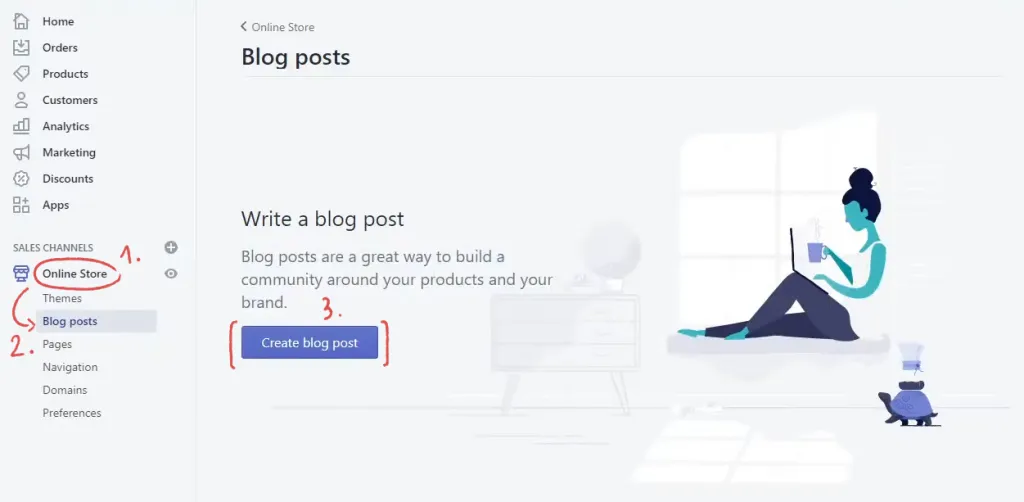
Shopify’s blog editor is actually very similar to its other pages, so this should be familiar to you. You may notice a new Excerpt field, which is a summary of the post that appears on the home and/or blogs page. If you do not enter an excerpt, Google will automatically generate it.
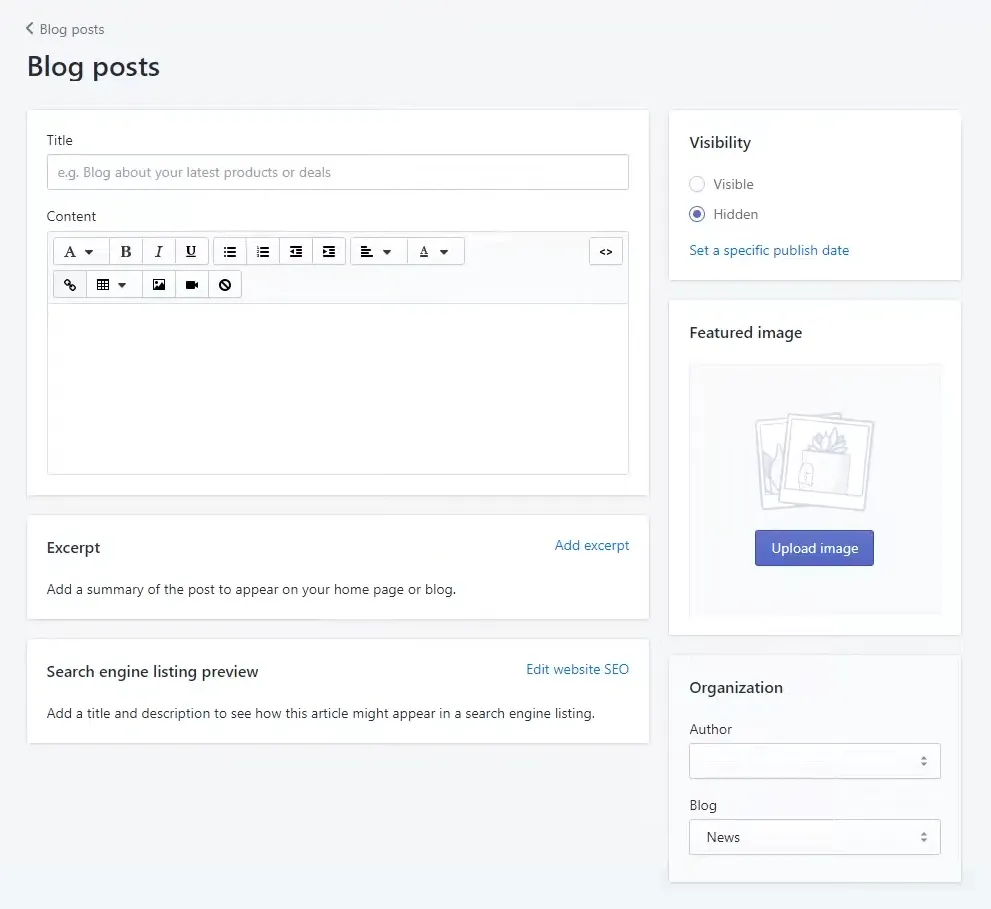
Start creating your blog by giving it a title and some content first. I recommend planning out the content in a separate Google Docs file beforehand to better structure your post.
Remember to add tags and a featured image. You can choose any user as the author of the article. Shopify comes with a blog called “news” by default, but you can create a new name if you’d like.
Head down to Search engine listing preview, click Edit website SEO. Here, you can edit page title, meta description, but more importantly, you can set a URL handle. Be sure to target relevant keywords to maximise your SEO.
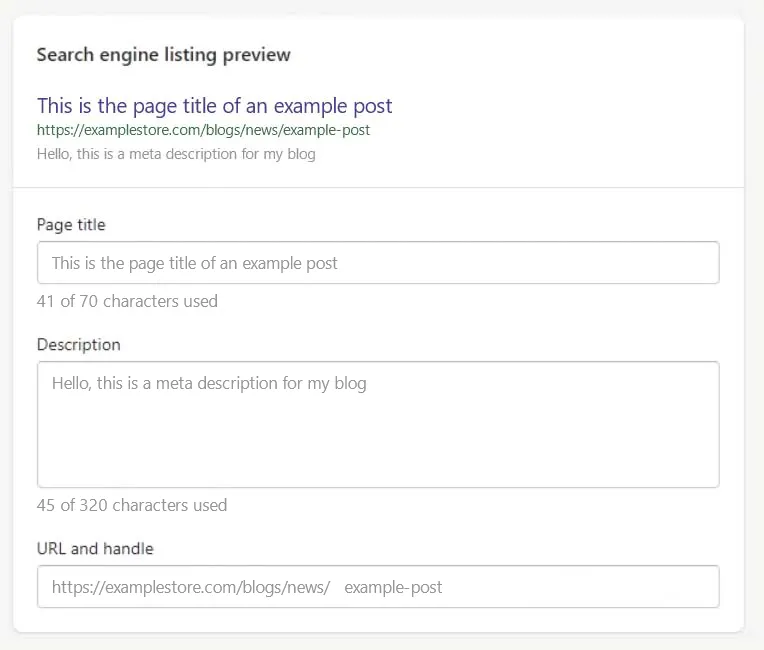
That’s it. You can choose to publish your post immediately or schedule for a later time by picking an option on the Visibility panel.
If you wish to update the blog later, you can find it in the same Blog posts menu.
How to find content ideas
Now that your blog is in place, here’s how to quickly find a year’s worth of content ideas.
Existing Category and Products Analysis
The absolute easiest starting point is with your existing categories.
Start by looking up each of your categories in a tool like SEMRush, compare the top 10 search results:
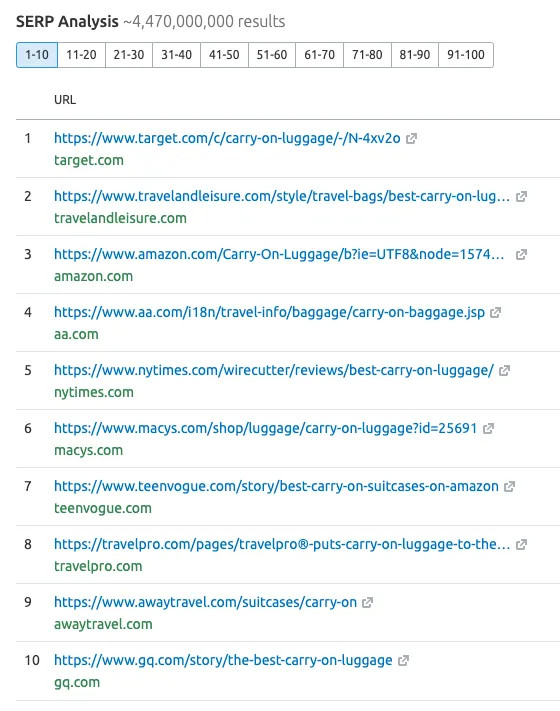
What’s the intent here? Are they all category pages similar to yours, informational content, or mixed intent?
If the intent is anything other than transactional, consider creating a complimentary information blog post to match the intent.
For example, if you’ve got a category for “carry on luggage”, based on the search results I’d consider creating a piece of content with a “carry on luggage size guide” and/or “what is the best carry on luggage”. Both seem to be ranked favourably by Google.
Then I would scroll up to the Keyword Variations, Questions, and Related Keywords section and look for other ideas in here:
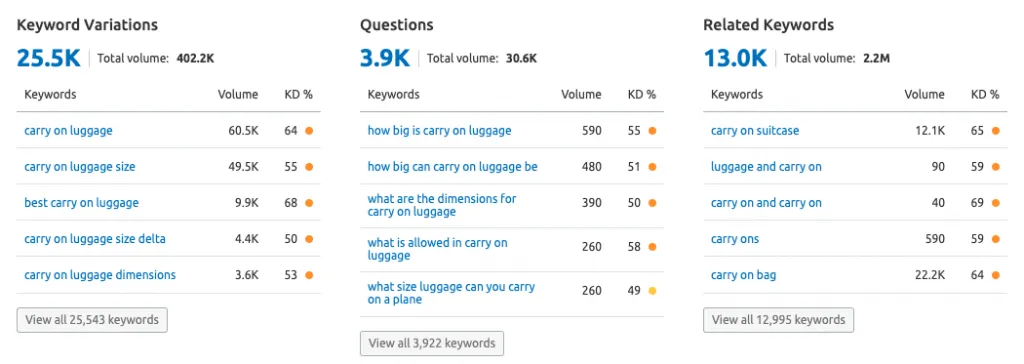
This approach is much more manual, but it’ll reveal a lot missed by the next much easier approach.
Content Gap Analysis
The easiest approach though is to do a content gap analysis (aka keyword gap).
Many tools like SEMRush can do a basic version of this within a matter of seconds by simply entering your website along with a few competitors. 30 seconds later, you’ll be presented with a list of all the keywords your competitors rank for that your website doesn’t.
Simply find their Keyword Gap tool under Competitive Research:

Enter your website along with some competitors, then click Compare:

You’ll now be given a list of all the keywords your competitors are competing for, along with the competitors’ position, search volume, keyword difficulty, and other metrics.

Make sure to pay attention to the tabs, by default it’ll be set to “shared” i.e. keywords where all competitors rank. But you’ll likely find a lot more opportunities under “Untapped”, “Missing”, and “Weak”.

You’ll also find some opportunities under the “Top Opportunities for” section above:

Shopify Blogging Best Practices
Always use Keyword Research
A lot of brands create content almost randomly. And while market knowledge can be invaluable in creating content, if you’re new to this, I’d highly recommend doing keyword research.
That means using a tool like SEMRush to verify people are searching for this. But more importantly, checking what else they’re searching for.
There are 230 global searches per month for “shopify blog seo”, but “blogging on shopify” has a whopping 8,900 searches per month. There’s a reason it’s in the title of this blog post.
Prioritise Middle of Funnel
If you sell workout supplements, it’s probably good for your brand to have content and traffic around workout tips.
That’s branding 101. If every time someone is looking for exercise tips, workout tutorials, and diet advice - they see your brand name, it’s much more likely they’ll buy from you later.
But in the mid-term, do you know what’s more effective?
When they’re interested in purchasing workout supplements and looking for comparisons, reviews, and advice for buying; that your brand and store come up.
This is what we call “Middle of Funnel”. It should be your priority for all content until you’ve run out of ideas.
Create Content in Topical Clusters
Google measures your E-A-T (expertise, authority, and trust) based on topics, not only overall. You may be highly qualified to give dental advice, but that doesn’t mean you’re qualified to give financial advice.
For SEO, it’s usually most effective to focus on a single topical cluster at a time.
This means if you sell a whole range of workout supplements, start with creating content around protein powder, then slowly expand from there.
You can establish your website as a trusted expert source for protein powder information first, before increasing this to other topics. This is achieved by having multiple pieces of content on a topic.
Recommend Relevant Products
Don’t start a blog only to keep your website updated. That’s a waste of time.
You should be increasing traffic and ideally sales too, hence the Middle of Funnel prioritisation.
One way to increase sales is by featuring relevant products within your articles. You can either do this at the end of the blog post or at the relevant part.
For example, recipes are a perfect way to promote ingredients your readers can purchase in your store. But don’t just name the ingredient, show them the product and make it clear they can purchase it on your website.
Use Internal Links
Internal links are a not-so-secret weapon in every SEOs arsenal, but often under-utilised.
This is where you link from one page to another on your own website.
It’s massively important for creating topical relevance (previous point), as well as increasing the authority (and therefore rankings) of individual pages.
If you’re trying to rank your blog posts, link to 2-3 relevant ones within or at the bottom of your article - especially any within this topical cluster.
But at a minimum, link to your category page on this topic. It can really help the rankings and also send traffic to your store.
Optimise Content for SEO
Doing keyword research already puts you ahead of most blogs, but to fully maximise your efforts, you’ll want to optimise your content.
In general, this comes down to:
- Use keyword research to identify blog post ideas.
- Write an optimised title tag, meta description, and H1 around these keywords.
- Include the main keyword in the article (usually near the beginning).
- Compare competitors articles to ensure yours is as good or better - reviewing their heading structure can be useful for this.
- Analyse their content with a tool like Surfer to understand how to optimise the page from a keywords, phrases, and topical coverage approach.
Include images, videos, and visuals
Another way to support your SEO, but more so your potential customers, is to make your blog posts look good.
This includes your website design, but also the usage of images, videos, table, charts, and any visuals to make your content more interesting to read.
Nothing will create a bigger bounce rate than a huge wall of text.
And bounce rate (i.e. someone bouncing off your website back to the search results) is a potentially negative ranking factor.
Shopify Blog Examples
If you’re looking for some examples of brands executing on this, here’s 3 successful Shopify blogs you can get inspiration from.
Beardbrand
Name: Beardbrand
Blog Organic Traffic: 195.4k
Blog Keywords: 36.5k
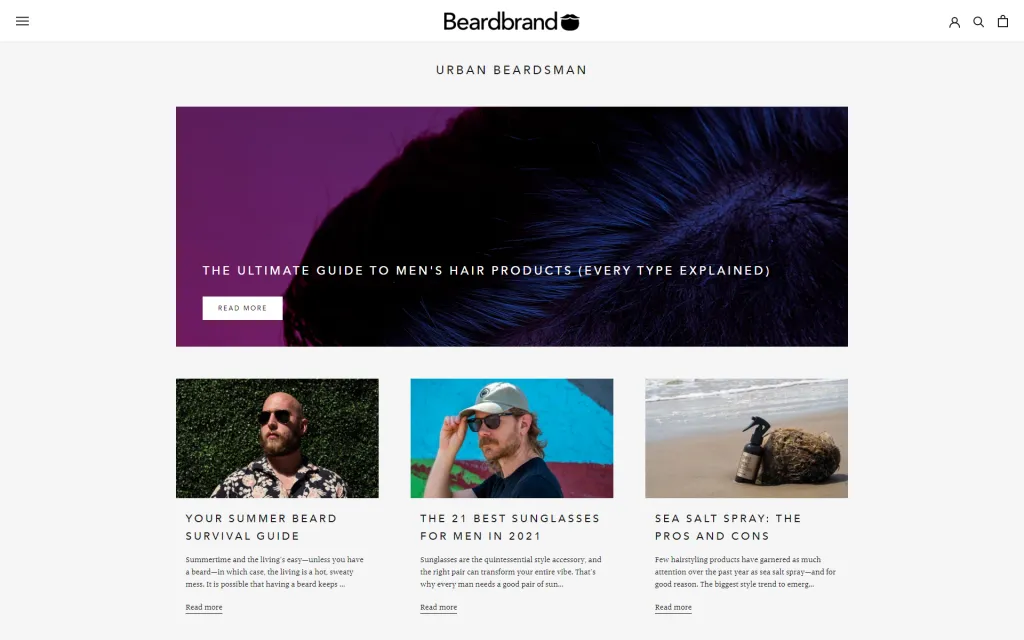
Beardbrand creates and sells products to help men grow, style, and manage awesome beards. Interestingly, they started as a blog first then store after, which no doubt has contributed to their huge success.
Their blog, Urban Beardsman, has 907 blog posts as of writing this and brings in a significant amount of traffic for their brand.

Their most popular blog post ranks #3 for “beard” with 165,000 searches per month and #2 for “beard styles” with 110,000 searches per month.
But it’s not all Middle of Funnel content, they’re creating content for their ideal audience, not just content that directly relates to their products.
Looking through their blog, you’ll find content on topics like “best sunglasses for men”, workout tips, and even book recommendations for men.
A further look will also reveal other strategies we mentioned in this article, such as internal linking:
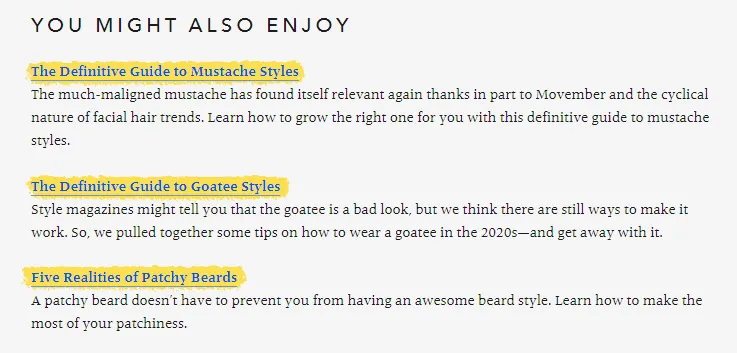
Using call to actions to sell products:

And even featured products at the bottom of every blog post:
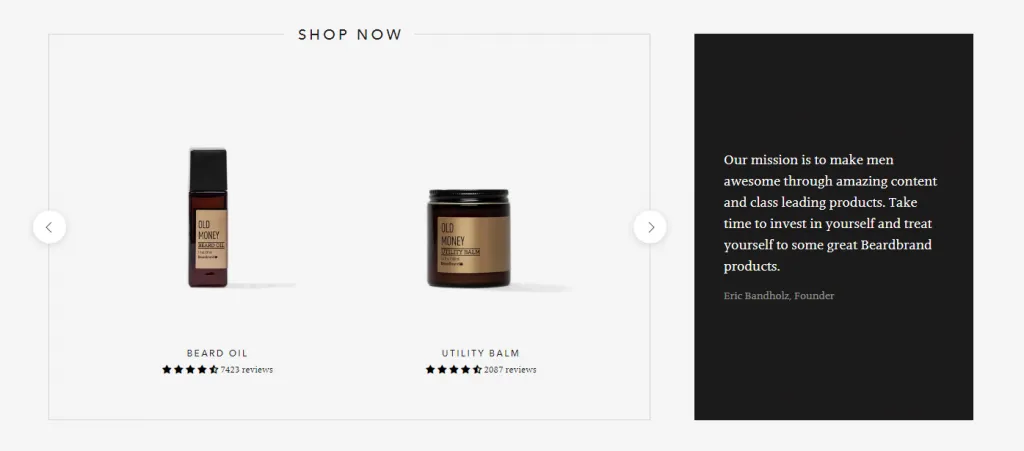
Luxy
Name: Luxy
Blog Organic Traffic: 213k
Blog Keywords: 82.2k
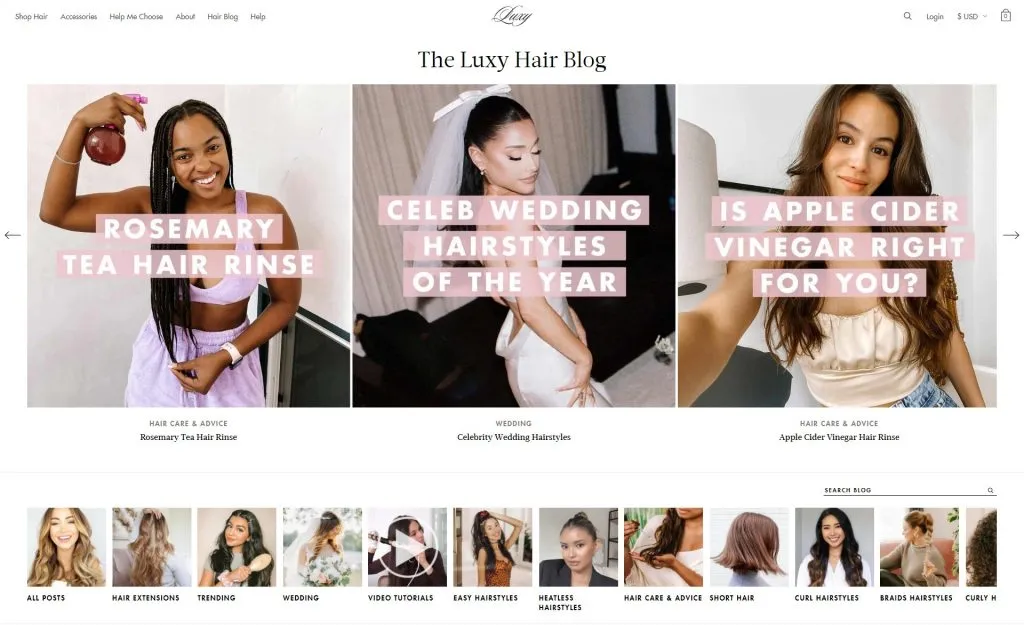
Luxy sells clip-in hair extensions and accessories worldwide for easy, beautiful hair.
As of writing this article, they’ve published 718 blog posts covering all things hair.
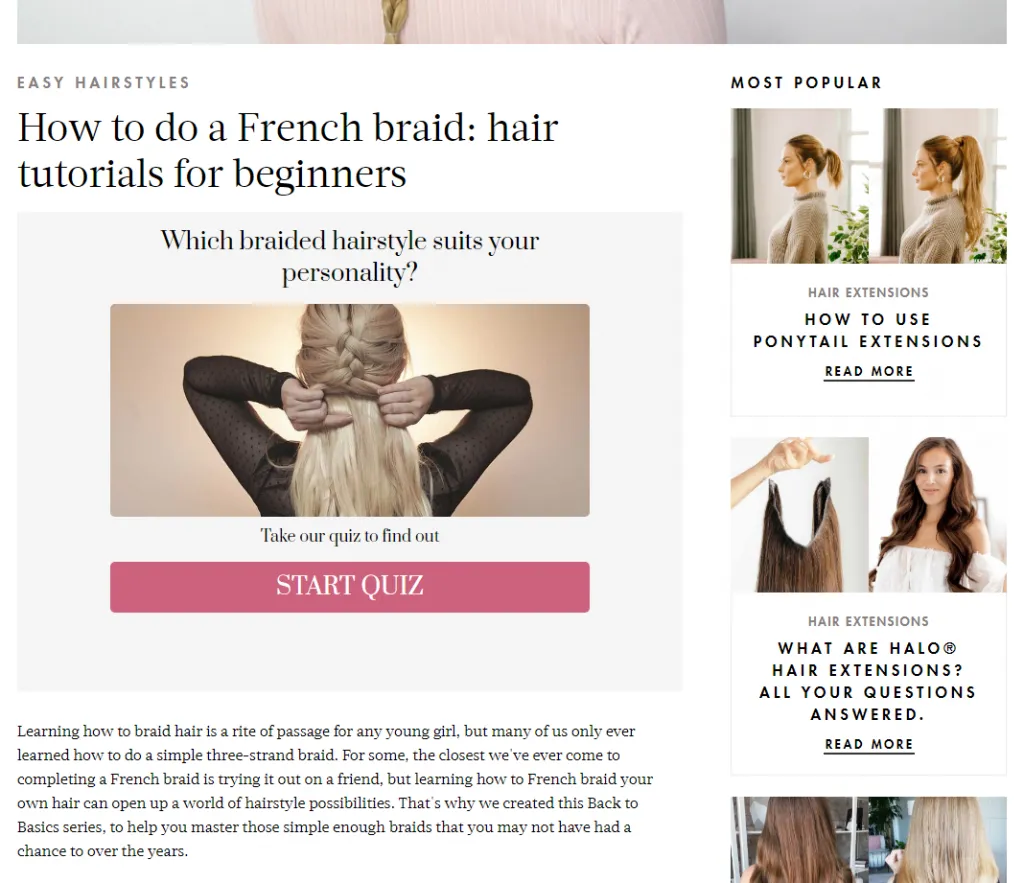
Their most popular blog post “How to do a French braid”, ranks #2 for “french braid” with 165,000 search volume per month.
One smart strategy you’ll see immediately on this blog post is their use of a quiz for collecting emails:

Once you fill out this little quiz, you’ll be presented with an option to “Enter your email to see your results!”.

Beyond this, they’re publishing a significant amount of content related to hair styles, hair care, hair tutorials, hair accessories, celebrities hair, and more. This is both Middle and Top of Funnel.
A closer look at their blog posts will show a significant amount of internal linking:
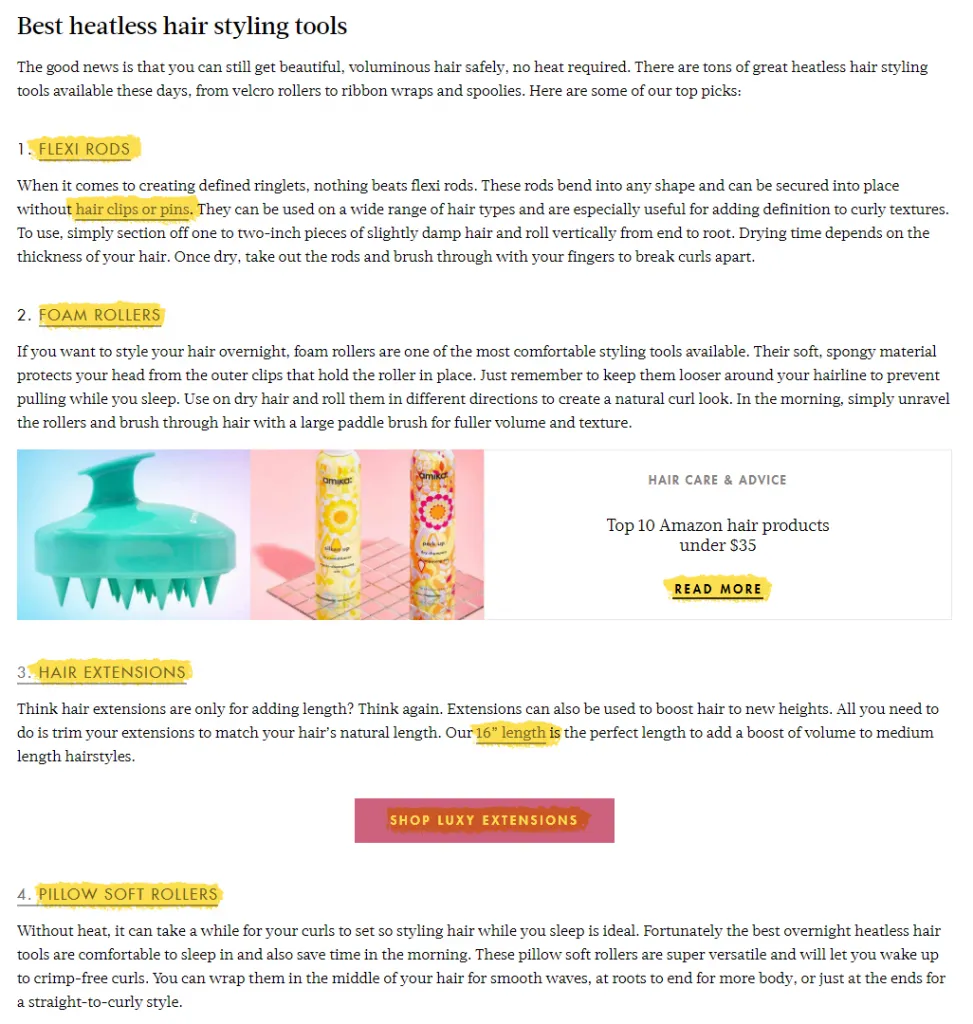
And relevant products featured at the bottom of each post:
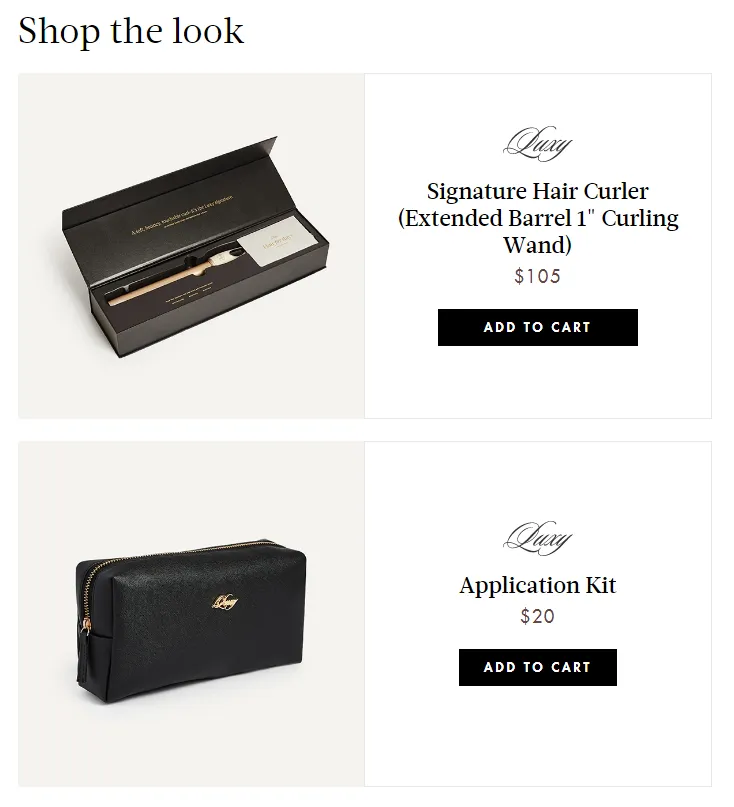
Gaiam
Name: Gaiam
Blog Organic Traffic: 113.7k
Blog Keywords: 63.2k
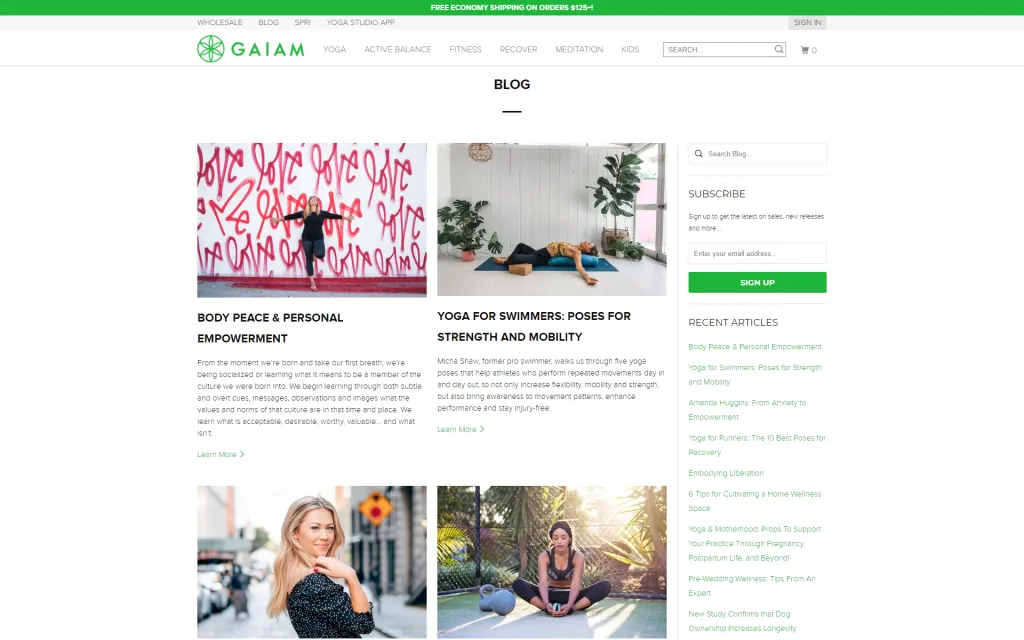
Gaiam is a lifestyle brand selling yoga, fitness, and wellness products.
As of writing this article, they’ve published 471 blog posts on topics related to mindfulness, yoga, nutrition, wellness, fitness, and more.
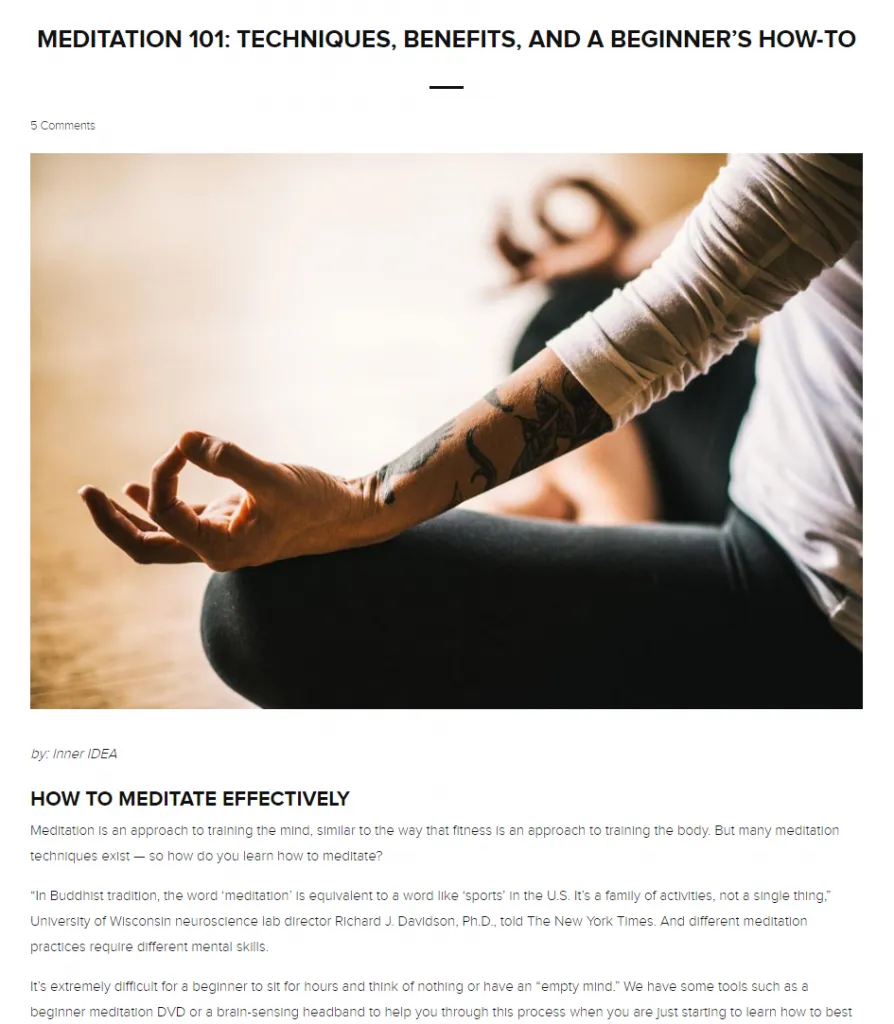
Their most popular blog post on meditation, ranks for keywords including “how to meditate” in position 7 with 74,000 searches per month, as well as “meditation” in #13 with 246,000 searches per month.
Most of their content is relevant to their product categories, even if not technically Middle of Content. This includes articles like yoga poses for swimmers, while while not relevant to purchasing yoga products, it’s at least targeted at their ideal customers.
Others are a bit closer to the Top of Funnel style though, such as Pre-Wedding Wellness tips. Again, focused more on the type of person they want to attract, rather than trying to sell something at this moment.
Despite their simple blog design though, you’ll still see internal links to sprinkled throughout their content:

And many of these leading to product category pages on their store:

Some posts also have a bit more of a call to action too:
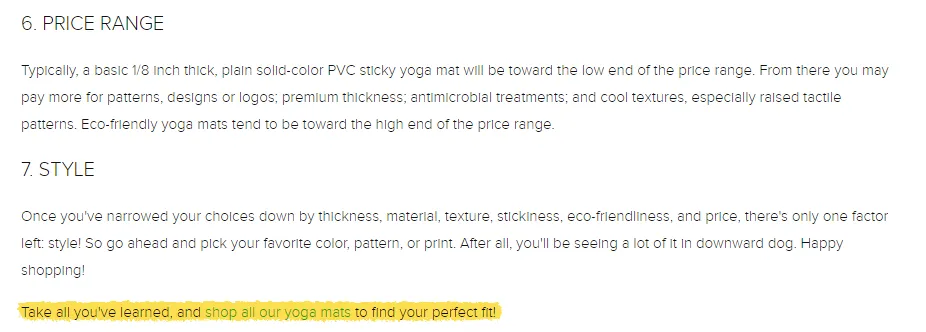
Though, I believe they could feature products a little better like Luxy shown previously.
Final Thoughts
Shopify isn’t an amazing blogging platform, it’s by far better as an eCommerce platform. But it’s also good enough.
And blogging for the right businesses can have a massive impact on not only your traffic, also your bottom line. At least, when done right.
If you fit into one of the 4 categories explained above, I’d highly recommend leveraging a blog as an additional traffic source.
There’s nothing quite like having customers search for their problem, choose to go to your website to learn the solution, then choose to buy your products as a result. No interruptions needed, they choose to go looking for you.
Looking for more Shopify SEO strategies?
Here’s some internal links to other content I’ve written on this topic:

